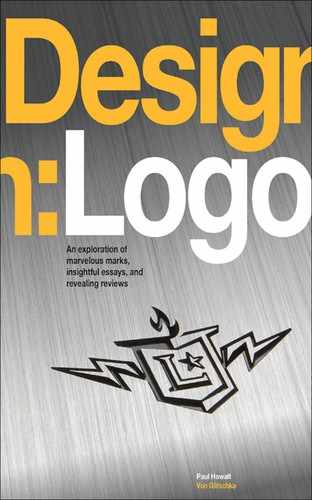
(Ray)
(Fogra 39)Job:08-30930 Title:RP-Design Logo
#175 Dtp:225 Page:156
001-272_30930.indd 156 9/2/13 10:12 AM
Essay
(Text)
I started my career in 1988, and since then, I’ve been fortunate
enough to create hundreds of corporate identities and logos.
I’ve worked in the precomputer world with ink, rubilith, and
stat cameras and seen the industry transformed by clip art logo
websites and most recently, a logo design software package for
$40 (£26). A lot has changed in the past twenty-ve years, and
I’ve seen the corporate brands of the world go from the simple,
to the complex, to the 3-D, to the animated, to the simple again.
All of this has formed my opinions about logo design.
1. I don’t create clip art logos anymore.
What is a clip art logo? It’s a logo symbol that if you switch
out the company name, can be used for any company. In the
past, I’ve created hundreds of them. Before the popularity of
clip art logo sites, I was guilty of repackaging logos created for
past clients (that were not chosen) and reselling them to new
clients. Lots of companies use these marks, but it isn’t optimum.
If another company could reuse your logo icon, that mark isn’t
unique—and what does that say about your company?
2. Acronyms are usually worthless.
Ever since IBM, everyone feels a three-letter ancronym is the
industry norm. But, what do three letters mean to anyone who
isn’t familiar with the company? Nothing. And, in the case of
brands we are familiar with, they lose that meaning over time.
Does anyone under thirty know that IBM stands for Interna-
tional Business Machines? That CBS stands for Columbia Broad-
casting System? Those brands have given personality to their
three letters over time. But for a new company, it simply doesn’t
add value (g. a, b).
25 Years of Logo
Design, Distilled
S H E R W I N S C H W A R T Z R O C K
ba
(Ray)
(Fogra 39)Job:08-30930 Title:RP-Design Logo
#175 Dtp:225 Page:156
001-272_30930.indd 156 9/2/13 11:03 AM

157
(Ray)
(Fogra 39)Job:08-30930 Title:RP-Design Logo
#175 Dtp:225 Page:157
001-272_30930.indd 157 9/2/13 10:12 AM
(Text)
3. I design more logotypes today.
In the past, I almost never created wordmarks, though I’m not
sure why. I think designers have something against them be-
cause they don’t highlight design skills in as obvious a manner.
The truth is they are easier to use across dierent applications
because they require less rules to implement. Still, let me just
say, I don’t believe in “just type” treatments unless they are built
from custom typography. The font choice does say a lot about
a company, but visually, I believe there needs to be something
more than just type to be memorable (g. c, d).
In the last decade or more, you’ve seen companies move
toward shorter names, which makes a logotype possible.
Amazon, Yahoo, and Google are just a few success stories.
4. Have a good roadmap.
How do you know if you’ve created the perfect logo? Know
what it should do, before you go about creating it. So often
logo design begins as an art project and not a communications
project. Save yourself time and make more eective work by
clearly dening the goals of your brand.
5. Get to the point.
In today’s marketplace, there is so much visual clutter, the con-
sumer doesn’t have much time to gure out who you are and
what you’re selling. Brands need to dene their product and
position in the marketplace as quickly as possible. This means
everything in a brand identity has to pull its weight. Now, more
than ever, renement from the company name to the visual
aesthetics is scrutinized.
I’ll use the Initio3i logo as an example. Initially, I designed this
mark for Initio Advertising (g. e, top). I started by creating
a custom typeface, then I added a unique element to it that
focused on the major change in our industry: Instead of broad-
casting messages to the masses, clients through advertising
communicate one-to-one with their audience. Great! Later, the
company split into two legal entities and the “3i” was added to
the mark (g e, bottom). Not so great, but we lived with it for
awhile. Finally, realizing that the personality and position of the
new company now revolved around the denition of 3i, we re-
ned the same concept into a simpler, more memorable mark.
Not an ideal process, but we found success in spite of it (g. f).
6. Environment is king.
This truth has never changed. I was taught this in school and
it’s still true today. Consider the primary point of contact where
your consumers interact with the brand. Build the mark to
t that environment. Some marks require exibility, where
others can leverage their exclusive real estate. A logo that lives
exclusively on a website, phone, or tablet has dierent consid-
erations than a mark that is embroidered on denim.
7. Don’t be an artist.
Finally, I would like to give all of the logo designers in the world
this piece of advice: If you are an artist, get out of this busi-
ness. Let me give some context. I dene an artist as someone
who has a voice, and they create work that conveys that voice.
Graphic designers aren’t artists, they are communicators. A
communicator projects the voice of the client. It’s very easy in
this profession to mix up the two. Too often we forget that our
visual preference does not outweigh the needs of our clients.
Don’t make that mistake.
edc f
(Ray)
(Fogra 39)Job:08-30930 Title:RP-Design Logo
#175 Dtp:225 Page:157
001-272_30930.indd 157 9/2/13 11:03 AM
..................Content has been hidden....................
You can't read the all page of ebook, please click here login for view all page.
